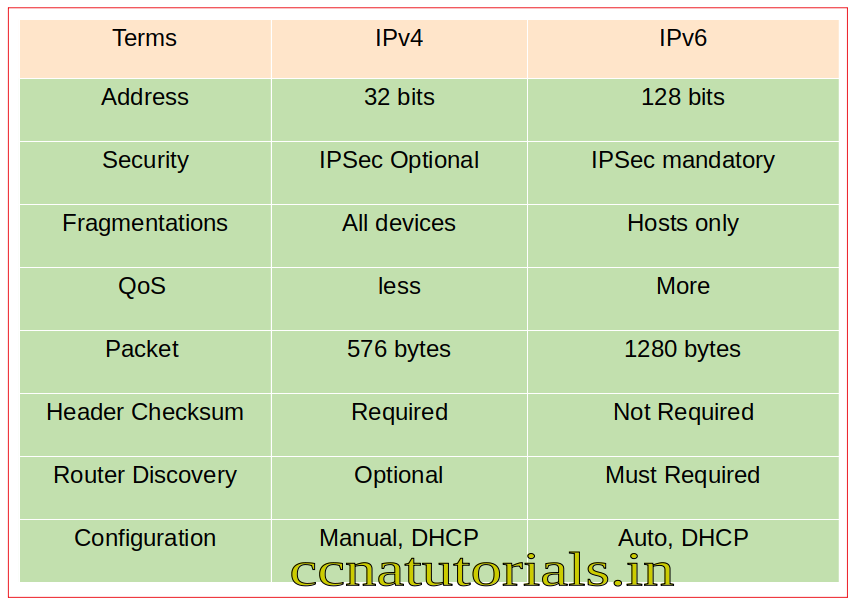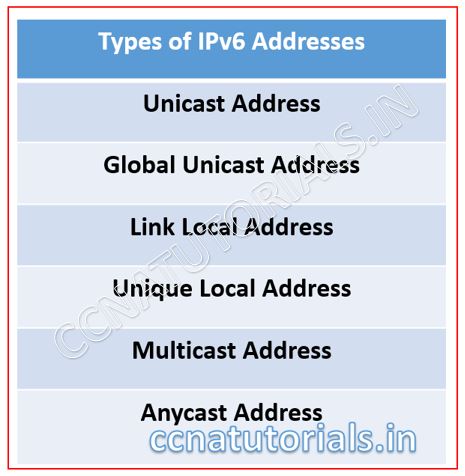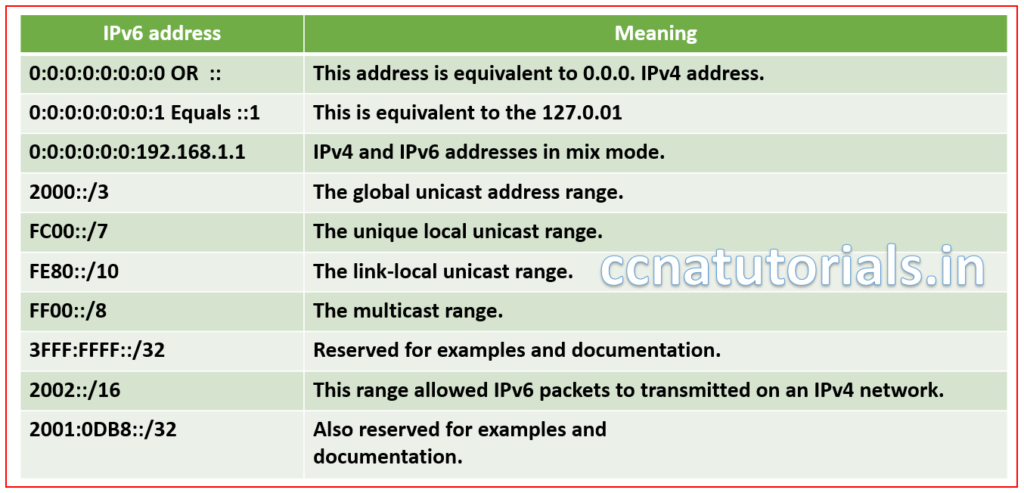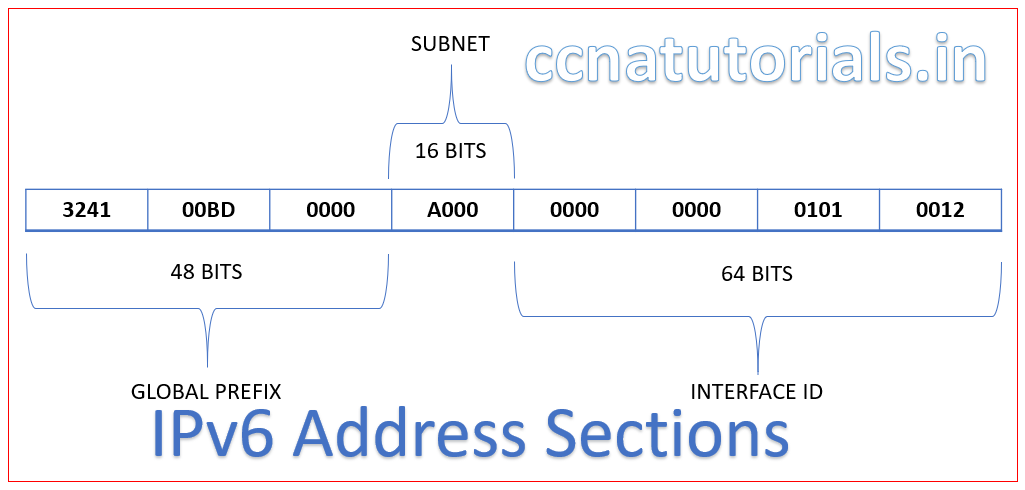In this article i describe the IPv6 Address system in computer networking for CCNA exam. It is also known as IP next generation or IPng. Internet Protocol Version6 IPv6 is a type of internet protocol which is newly introduced in computer networking. We know about IPv4 and works with IPv4 for inter-networking and local networks. IPv4 address is a combination of 8 bytes or 32 bits. Every device connected in a network or internet required an unique IP address. There are billions devices which works on internet.
IPv4 have limited IP addresses that is 2^32. Which are not sufficient in today scenario. To overcome this problem Internet Protocol Version6 IPv6 invented by IETF team. IPv6 address is a combination of 128 bits. So we have now 2^128 addresses to use in inter-networking or internet.
The numbers of IPv6 are billions of billions. These address provides security better than IPv4. Later I describe the security concern with IPv6 Address system in computer networking. The main purpose of using IPv6 Address system in computer networking is to increase the IP address for devices connected in internet.
Internet Protocol Version6 IPv6 description in brief.
Initially the IETF ( Internet Engineering Task Force) developed the internet protocol to provide the communication between devices in a network. IPv4 developed to provide the unique identity to the devices of network. Internet was used by the cooperative organizations in these days.
But now every body need internet via mobile or computer. So the addresses provided by IPv4 become less than the users. To overcome this problem NAT( Network Address Translation) technique used in routers. IPv6 is the perfect solution to overcome the sufficient address problem and eliminate the NAT technology.
IPv6 Address system in computer networking follows the IPv4 protocols and allow the devices to communicate with each other over internet. Internet Protocol Version6 IPv6 comes in 1998 for commercial use but the devices was not compatible with IPv6. Now all devices are compatible with IPv4 and IPv6.
Important factors about the Internet Protocol Version6 IPv6.
There are many special characteristics of IPv6 Address system in computer networking presents over the existing IPv4 address system. The main thing about IPv6 Address system is the large numbers of address provided by IPv6.
We can say the IP address increased from 2^32 to 2^128. The IPv6 improves the packet transfer capacity of networking devices like router and switches. Internet Protocol Version 6 IPv6 provides the auto configuration of address like IPv4 but more efficiently.
IPv6 can handle a large packet payload comparison to IPv4. Identity of devices and data packets become more easy and efficient. Point to point communication efficiency of networking devices increased comparison to IPv4. Compatible for handy devices like mobiles and tabs. The main and important function of Internet Protocol Version 6 IPv6 is that it is compatible with IPv4 protocol. Means different devices used IPv6 and IPv4 can communicate with each other. It is known as Dual stacking in networking.
Dual Stack of IPv4 and IPv6 in computer networking
When IPv4 and IPv6 protocols running together at same time, it is known as Dual Stack. Dual Stack term used when a router works with two or more routed protocols. Router forward the packet without disturbing other router.

Similarly the working of router with IPv4 and IPv6 together routers works for tunneling for IPv6 over the IPv4 carrier. Which is important for networking devices as IPv4 is not absolute completely and devices are depends on both IPv4 and IPv6 protocols.
IPv6 Address system in computer networking improves the efficiency of data flow in the network. The changes of IPv4 to IPv6 become most popular all over the world because of dual stack operation. Cisco networking equipment’s fully supports the dual stack operation. All latest operating systems like Microsoft windows, MAC os, Linux and mobile operating systems supports the Internet Protocol Version6 IPv6.
Requirement of IPv6 Address system in computer networking
The main reason for need of Internet Protocol Version6 IPv6 is the limited address availability with IPv4 system. We used many techniques to work with limited network addresses like IPv4, VLSM etc. No doubt these techniques do the great jobs to conserve the IP addresses globally but not sufficient in today scenario.
So we required another powerful alternate of IPV4 and then IPv6 invented by the IETF in 2000 decade. The number of devices increased day by day on internet and we have limited resources. We used computers, phones, game consoles, routers, switches and other devices on internet. Every device required an IP address to access the internet or network. IPv4 is not such powerful to allot IP address to all these devices for all peoples globally.

The advantages of use of IPv6 Address system in computer networking
IPv6 Address system in computer networking is the upgrade version of IPv4. Current IPv4 address approx 4 billion become vanish as mostly people uses the internet on computer and mobile phones.
IPv6 provides the salability which provide an unique and permanent IP address to each device connected in network or internet. IPv6 provides the self configuration of IP addresses to each device by the help of SLAAC and DHCP. The IPv6 provides an additional layers of security to network like IPSec and other encryption key methods.
It provides the end to end connectivity to networks which reduces the use of NAT in routers. IPv6 provides the multicast and any-cast functionalities to networking devices. The most important advantage of IPv6 is Dual Stack feature which allow the compatibility of IPv4 and IPv6 with each other.
In today scenario many unforeseen requirements of networking was not considered in IPv4 configurations. IPv6 overcome these requirements of IPv4 techniques. The data carrying capacity improves in an IPv6 enabled network or internet. Broadcasting of data became easy and reliable because of the IPv6 multicast broadcast feature.
Types of IPv6 Address system in computer networking
We know the types of IPv4 addresses like unicast, broadcast addresses. IPv6 address types also defined according to requirement of IPv4 address system. These addresses are required for data packet transfer within a network or internet.
IPv6 address system have its own address systems like unicast, link local and unique local address and multicast address. In this section lets describe the different IPv6 address types below.

Unicast address in IPv6 Address system in computer networking
Unicast means transmitted for a particular device. The unicast packets delivered to a single interface. The interface may be of any computer or router or switch. We know every device need an interface to connect with any network or internet. An unique IP address assigned to that interface. This unique address works as unicast address. IPv6 address system have same unicast address system like IPv4 address system.
Global unicast address in IPv6 Address system in computer networking
IPv6 Global unicast address is routable address like IPv4 address system. IPv6 Global unicast address starts from 2000::/3. The last 64 bits of an IPv6 address works for router interface addresses. These 64 bits are the unique host ID for a networking device. ISP provides only starting 48 bits for global unicast address for interface or networking device like router.
Link Local address in IPv6 Address system in computer networking
Link local addresses are like APIPA ( Automatic Private IP Address. These addresses not required to be routed in networking devices. In IPv6 address types the link local address starts with FE80::/10 . here /10 means only first 10 bits are used for link local address in IPv6 address system. The link local address allows to create small LAN which do not required to be routed but use the network for sharing resources locally only.
Unique local addresses in IPv6 Address system in computer networking
Unique local addresses are also used for local network. The unique local addresses are also not routed on internet routing devices. These addresses are similar to the private IPv4 address system. These addresses are globally unique addresses. Unique local addresses starts from FC00::/7 similar to the link local addresses describes above. IPv6 unique local address replaced the site local addresses like IPv4 private addresses.
Multicast addresses in IPv6 Address system in computer networking
Multicast address packets delivered to all interfaces routed in routers. The Multicast addresses also known as one to many addresses. In IPv6 address types the multicast address starts with FF.
Anycast address in IPv6 Address system in computer networking
An anycast address denotes the multiple interfaces on multiple devices. The anycast packet delivered to a single device only. Anycast addresses configured on routers only. A source address of a packet never be an anycast address.

IPv6 address system have the similar IPv4 addresses which we are generally used in networking. Example of these common addresses is local address 127.0.0.1. below is the list of similar addresses used in IPv6 address system. See the below list of some special IPv6 addresses.
Expression of IPv6 Address system in computer networking
IPv6 address length is 128 bits, we know the length or IPv4 is 32 bits. Expression of IPv4 is very easy because the IPv4 address used the decimal numbers for addressing. It is easy to configure the IP address with decimal figures. There are only 4 bytes in IPv4 but in IPv6 there are 8 section of hexadecimal format.
IETF make it easy with some predefined rules for IPv6 address expression. IPv6 address expression means how to denote the IP address. As there are 8 sections of 16 bits each so it is very difficult to remember these addresses. Let’s see the special about the IPv6 address expression in networking.

See the above image, in this image the IPv6 address breaks into different sections. The first 36 bits known as Global prefix bits. next section of 16 bits is the subnet mask for that global prefix. The last 64 bits works for the interface ID of the connected device or network device. It is clear that the IPv6 have 8 groups of bits and the IPv4 have only 4 groups of bits.
How to write the IPv6 address?
It is very difficult to remember the IPv6 address because of its length and format. We can short the IPv6 address by following some tricks. There are some predefined rules for IPv6 address expression.

First thing is that IPv6 address used the semicolon in place of dot as in IPv4 address. Remember the IPv4 address looks like 192.168.1.2. IPv6 address format replace the dot with semicolon. The IPv6 address looks like 3241:00BD:0000:A000:0000:0000:0101:0012
Here the dots replaced with semicolon and each section is a hexadecimal figure. Our question was that how to write or remember the IPv6 address. Some predefined rules to shorten the addresses are below.

The first thing with IPv6 address is that you can eliminate the 0 from each section. After doing that the above IPv6 address look like 3241:BD:0:A:0:0:101:12. You see the modified address looks like easy than the original address.
The next rule to write the IPv6 address is you can eliminate the two consecutive 0’s by replacing with a double column. For example, the 0000:0000 can be written as :: . So, the example we have taken above can be written as 3241:BD:0:A::101:12. Now our IPv6 address become more short. These rules make it little bit easy to write the IPv6 address.
Example of IPv6 address expression
Lets take another example of IPv6 2111:0000:0000:0A11:243B:0000:0000:0001. By following the first rules to eliminate 0 with column symbol. The taken address written as 2111:0:0:A11:243B:0:0:1. The IPv6 address become short by applying the first rule. Now apply the second rule than the above address become more shorter like 2111::A11:243B::1 . now this address can easily written and remembered by some one.
In this article I describe the IPv6 Address system in computer networking. The need, types and expression of IPv6 Address system in computer networking. .
I hope you found this article helpful. For any query or suggestion you may drop a comment below or contact us. We always welcomes your suggestions to improve this website.







Like!! I blog quite often and I genuinely thank you for your information. The article has truly peaked my interest.
Thanks for fantastic info I was looking for this info for my mission.
These are actually great ideas in concerning blogging.